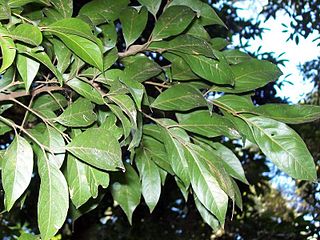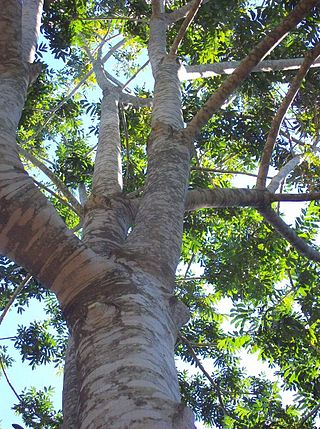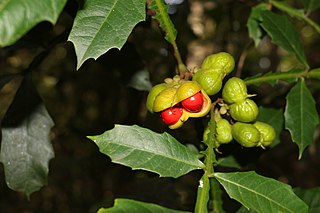
Heptapleurum arboricola is a flowering plant in the family Araliaceae, native to Taiwan and Hainan Province, China. Its common name is dwarf umbrella tree, as it resembles a smaller version of the umbrella tree, Heptapleurum actinophyllum.

Harpullia is a genus of about 27 species of small to medium-sized rainforest trees from the family Sapindaceae. They have a wide distribution ranging from India eastwards through Malesia, Papuasia and Australasia to the Pacific Islands. They grow naturally usually in or on the margins of rainforests or associated vegetation.

Aphloia is a genus of flowering plants that contains a single species, Aphloia theiformis, the sole species of the monogeneric family Aphloiaceae. It is a species of evergreen shrubs or small trees occurring in East Africa, Madagascar, the Mascarene Islands and the Seychelles.

Polyscias murrayi, known as the pencil cedar, is a very common rainforest tree of eastern Australia.
Endosamara is a monotypic genus of flowering plants in the legume family Fabaceae, tribe Wisterieae. Its only species is Endosamara racemosa, a liana found from South India through Indo-China to the Philippines.

Elattostachys nervosa, known as the green tamarind or beetroot tree is a common rainforest tree of eastern Australia. Found in all types of rainforest, growing from Paterson, New South Wales in the south to Gympie in south east Queensland. The name Elattostachys refers to "little spikes", a flower feature of other plants in this genus. Nervosa refers to the prominent leaf venation. Beetroot Tree refers to the beetroot red leaves of the new growth.

Paeonia clusii is a relatively low (25–50 cm) species of herbaceous peony with scented, white or pink flowers of up to 12 cm in diameter. In the wild, the species can only be found on the islands of Crete and Karpathos, and Rhodes. It has pinkish-purple stem up to 30 cm long and glaucous dissected leaves. P. clusii blooms in mid-spring.

Sarcopteryx stipata, known as the steelwood, is a rainforest tree of eastern Australia occurring from the Bulga Plateau and Comboyne Plateau north west of Taree, New South Wales as far north as Fraser Island off the coast of south eastern Queensland. It grows in sub tropical rainforest but sometimes occurs in warm temperate rainforests on poorer soils. It is a member of the soap berry family. The generic name Sarcopteryx translates to "fleshy wing", as the fruit can be wing shaped. Stipata means "surrounded". The common name steelwood refers to the very tough, hard and heavy timber.

Pseudoweinmannia lachnocarpa is a rainforest tree of eastern Australia. Common names include rose marara, mararie, scrub rosewood and red carabeen. The species name lachnocarpa is from the Greek, referring to the "woolly fruit". The genus name refers to the similarity of another genus, Weinmannia, after the German eighteenth century pharmacist J.W. Weinmann.

Dysoxylum rufum is a rainforest tree in the family Meliaceae, found in eastern Australia. It occurs on a variety of different soils and rainforest types. From as far south as Bulahdelah, New South Wales to the McIlwraith Range in far north eastern Australia. The specific epithet rufum refers to the rusty red of the leaf, fruit and flower hairs of this species.
Borthwickia is genus of flowering plants, containing one species, Borthwickia trifoliata from Yunnan, China and Myanmar. The common name in Chinese is 节蒴木. It is a shrub or small tree with evergreen trifoliate leaves, whitish flowers clustered at the tip of the branches, with many stamens, and thin, knobbly, drooping fruits with many small red seeds.

Dysoxylum arborescens, commonly known in Australia as Mossman mahogany, is a small tree in the mahogany family Meliaceae. It is native to rainforests of Malesia, Papuasia, Queensland and nearby islands.

Barberetta is a genus of herbaceous perennial plants in the family Haemodoraceae. It contains only one known species, Barberetta aurea.

Leucospermum prostratum is a trailing shrub of up to 4 m (13 ft) in diameter from the Proteaceae. It has alternately set, about 3 cm (1.2 in) long, lance-shaped, olive-colored, upright leaves, and produces sweetly scented, compact, hemispherical flower heads, with long styles sticking out far from the perianth tube, which jointly give the flower head the appearance of a pincushion. The fragrant flowers found between July and December are initially yellow but turn orange when older. It is an endemic species restricted to the south coast of the Western Cape province of South Africa. Its common name is yellow-trailing pincushion.

Harpullia alata, common name -winged tulip or wing-leaved tulip, is a tree in the family Sapindaceae, endemic to eastern Australia, and found from Brisbane, Queensland to Grafton, New South Wales.

Harpullia leichhardtii is a tree in the family Sapindaceae, endemic to the Northern Territory.
Zanthoxylum austrosinense, or South Chinese Sichuan pepper, is a woody plant in the family Rutaceae and is native to southern China.

Zanthoxylum avicennae is a woody plant in the family Rutaceae.
Zanthoxylum dissitum is a woody plant native to China. It grows in upland thickets and open forests, forests, at 300-2600 m altitude.

Harpullia ramiflora, commonly known as the Claudie tulipwood or Cape York tulipwood, is a tree in the Sapindaceae family native to north east Queensland, New Guinea and parts of Malesia.

















